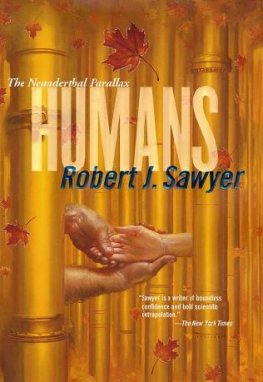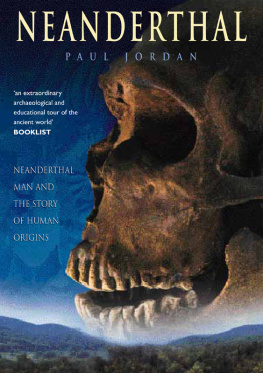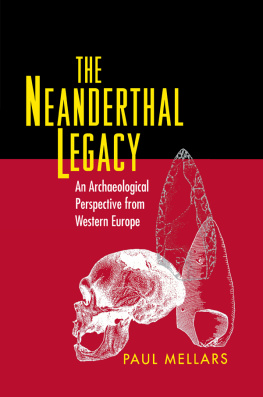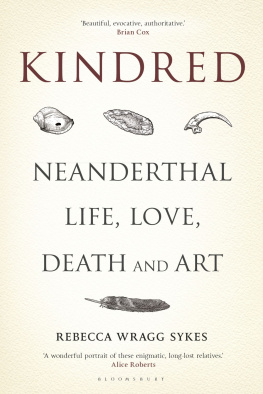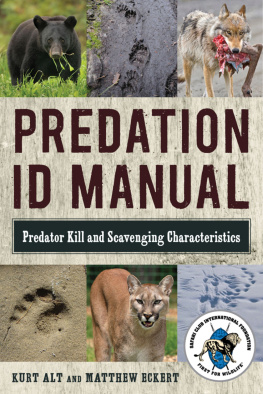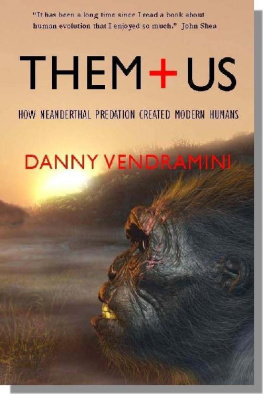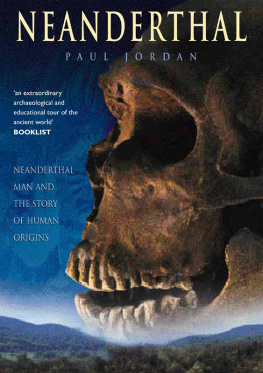THEM ANDUS
HowNeanderthal predation created modern humans
by
DannyVendramini
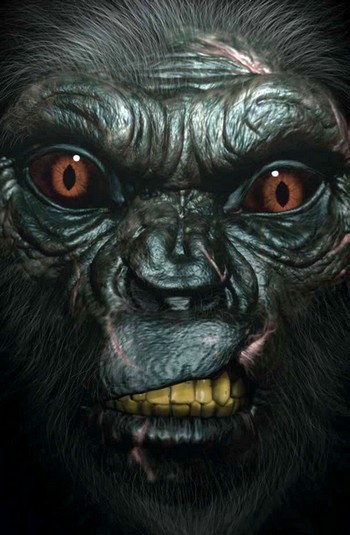
SmashwordsEdition: 2012
Copyright Danny Vendramini 2009
DannyVendramini asserts his right under the Copyright Act 1968 to beidentified as the author of this work.
All rightsreserved. Apart from any fair dealings for the purposes of privatestudy, research, criticism or review, as permitted under theCopyright Act 1968, no part of this publication may be reproduced,stored in a retrieval system, or transmitted in any form or by anymeans: electronic, mechanical, photocopy, recording, or anyotherexcept for brief quotations in printed reviews without theprior permission of the publisher.
NationalLibrary of Australia Cataloguing-in-Publication entry:
Vendramini,Danny, 1948
Them and Us:how Neanderthal predation created modern humans
Includes index,bibliography
1. Anthropology Predation (Biology) Human evolution Neanderthals Humanbeings 304
First publishedin Australia by Kardoorair Press PO Box 478, Armidale, NSW 2350,Australia http://www.kardoorair.com.au
Print editiondesigned and typeset by Helen Forlong, WordWitches, Sydney,Australia http://www.wordwitches.com
Authorphotograph: Josie Vendramini
Cover image:Arturo Balseiro, Dharma Estudio
SmashwordsLicense Statement
This ebook islicensed for your personal enjoyment only. This ebook may not bere-sold or given away to other people. If you would like to sharethis book with another person, please purchase an additional copyfor each reader. If youre reading this book and did not purchaseit, or it was not purchased for your use only, then please returnto Smashwords.com and purchase your own copy. Thank you forrespecting the hard work of this author.
To my father,who said, Be intuitive. And to Rosie, who said, Berigorous.
ACKNOWLEDGEMENTS
Science is acollaborative pursuit and I am indebted to the authors of the 800papers and academic sources Ive quoted in this book. Without theirbricks, there would be no house. In particular, my thanks to TordKjellstrom, Iain Davidson, Johan M G van der Dennen, Coral Wynter,Erik Trinkaus, Svante Pbo, Heather Smith, John Shea, TonyMcMichael, Paul Mellars, Susan Antn, David Pearce, Erella Hovers,and Michael Kaplan. Likewise, Im especially indebted to mydaughters Josie and Bella, Emily Walker, Bernard Shirley, KeithJohnson, Ned Walker, Andrew Bell, Tom Markham and my publisher TonyBennett for their invaluable editorial input and advice.
My thanks alsoto Arturo Balseiro, Creative Director of Dharma Estudio, for hisforensic reconstructions of a Neanderthal and to Helen Forlong fromWordWitches for her scholarly editing and fabulous book design.Above all, my thanks and appreciation to my wife, muse, mentor andlifelong editor, Rosie Scott.
ILLUSTRATIONS
To reproducethe forensic reconstruction illustrations of the La FerrassieNeanderthal in Chapter 8 and on the covers, refer to our websitefor conditions.
Some materialsin the book are copyright and are reproduced for research andeducational purposes only, under fair use provisions of theCopyright Act 1968. They have been selected at the discretion ofthe author as they represent principles discussed in the text. Nocompany whose product appears in any advertisement reproduced inthis book, nor any company that prepared such an advertisement, isin any way responsible for the opinions expressed in this book.
www.THEMANDUS.ORG
For extrainformation, coloured illustrations and other material, or to buythe printed book, visit the Them and Us website: http://www.themandus.org .
REFERENCES
This bookcontains 793 scientific references (numbered sequentially) whichcan be downloaded as a PDF from the books website: www.themandus.org
If you prefer,here is the direct link to the PDF:
http://www.themandus.org/References-them+us.pdf
preface
Ive alwaysloved movies about mythic heroes battling the forces of evil, butin the 1970s, when I heard that George Lucas had based Star Wars onancient hero myths, my lifelong fascination with mythology reallytook off.
In 1999,inspired by American anthropologist Joseph Campbells work onuniversal myths, I started researching a book on the relationshipbetween myths and movies. I wanted to explore why widely disparatecultures, often with no contact with one another, somehow came upwith virtually identical mythic stories. From ancient Mesopotamiato modern Manhattan, from Amazonian Indians to American matrons,humans appeared so viscerally attracted to the same mythicthemesgood and evil, sex and violence, heroes, quests, perilousjourneys, dragons and other monstersit was as if they had beenhardwired into our genes.
I wanted toinclude one chapter in the book to explain exactly how these heroictales came to be so universal that audiences around the world allresponded in much the same way. But when I went to the literature Icouldnt find a satisfactory biological explanation. Yes, there wasJungs theory of the collective unconsciousbut for my purposes,that appeared too steeped in a quasi-spiritual ethos to provide ascientifically valid explanation.
I eventuallyrealised there was a serious gap in the biological model somethingmissingwhich I found so intriguing that I put the book aside.Instead, I began researching how humans and other animals acquirenew instincts, innate behaviours and emotions.
Six yearslater, the British journal Medical Hypothesis published the resultsof my research, Noncoding DNA and the Teem theory of inheritance,emotions and innate behaviour. The paper presented a radical newtheory of the evolution of behaviour to explain how animalsacquired new instincts and emotions. Its central proposition wasthat high intensity emotional experiences (usually caused bytraumatic events like predator attacks, accidents and naturaldisasters) can, under certain circumstances, be permanently encodedinto an area of an animals genome called nonprotein-coding DNA.This is the part that is usually dismissed as junk DNA.
It soon becameapparent that Teem theory was a kind of master key that couldopen other doors, for instance, explaining how humans acquired therepository of innate behaviours and emotions we call human nature.When I applied Teem theory to what had transformed humans fromstone-age African hominids into fully modern humans, why we lookand act the way we do, and even why were obsessed with sex andviolence and good and evil, it proposed a single simple explanationthat was both extraordinary and unexpected.
The result is aunified theory of human origins called Neanderthal Predation theory(or NP theory) which is based on a fundamental reassessment ofNeanderthal behavioural ecology. Exciting new evidence revealsNeanderthals werent docile omnivores, but savage, cannibalisticcarnivorestop flight predatorswho hunted, killed and cannibalisedour archaic ancestors in the Middle East for 50,000 years. Whatsmore, Neanderthals were also sexual predators, who raided humancamps to rape, and abduct young females, leaving a trail ofhalf-cast inbreds.
Thismulti-faceted predation eventually drove our ancestors to the brinkof extinction. Genetic evidence reveals that at one stage ourentire ancestral population was reduced to as few as 50 people.
The only humansto survive the predation were those born with mutations forsurvivalist adaptationsmodern human traits like languagecapacity, Machiavellian intelligence, coalition building,creativity, risk-taking and aggression. These traits effectivelytransformed them from a prey species to a virulent new hunterspecies


